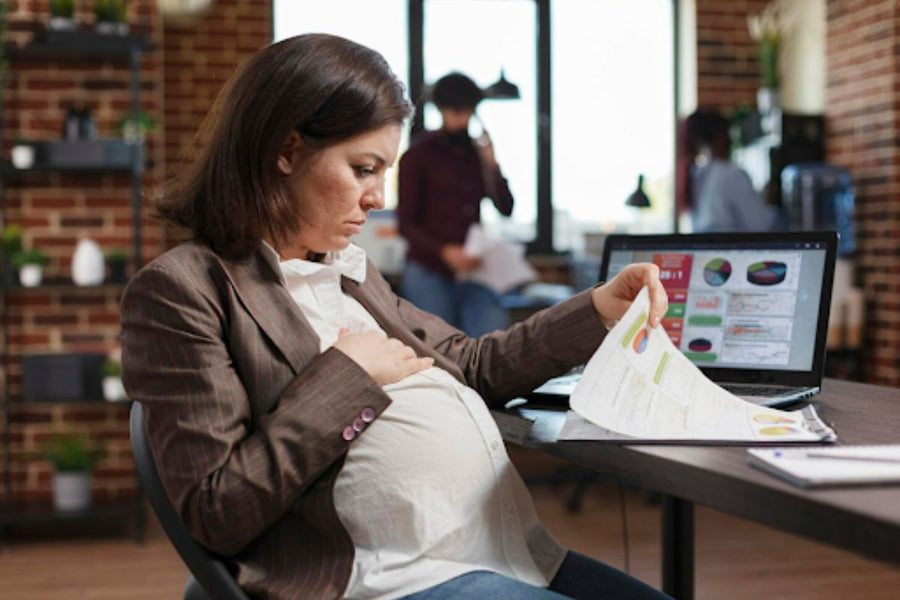Written by Maternity Physiotherapist Johanna Kjelseth
“When will I be back to normal after pregnancy?” is a common question for pregnant women and new moms. In the age of social media filled with influencers and celebrities with their flat stomachs only a few weeks postpartum, many women feel insecure about how long it takes for them to heal. What we need to understand is that the healing process is a lot more than just getting back to the pre-baby-weight or having a flat stomach. It`s about feeling good in your own skin, being able to function without pains and aches and generally being content with yourself again.
The recovery time is very individual and there are many factors that play a role. That`s why it is impossible to say when YOU are fully recovered and “back to normal”. The recovery takes time. It won't happen overnight. It took nine months to make a baby, and it usually takes at least that long to get back into shape again.
Let`s look at the factors that play a role in your recovery.
After the delivery
After giving birth, big physical changes take place in a woman`s body. Right after delivery the womb starts shrinking and goes back to its original size around six weeks postpartum. This allows the internal organs to find their own places again and will also ease your breathing as the lungs get more space. The separated abdominal muscles, diastasis recti, slowly begin to recover and find their way closer to each other. The natural recovery of abdominal muscles is known to be fastest during the first 2 months, but it can still occur for at least a year (and even longer if the separation has been large) after the delivery.
The pelvic floor muscles and the vagina stretch during childbirth, and they may experience tearing and bruising. However, the vagina has good blood circulation and usually heals quickly without leaving scars. The vaginal swelling during childbirth also decreases rapidly. Vaginal recovery from childbirth takes a few weeks, and pelvic floor function usually returns to normal within the first two to three months. However, recovery continues after childbirth for at least another year.
After a C-section the uterus, abdominal wall, and skin need to heal. The initial healing occurs within 4 to 6 weeks postpartum, but also continues after that.
Learn more: Diastasis Recti Symptoms and how to treat it
Hormonal changes
After you deliver the baby and placenta, your hormone levels drop dramatically and begin a long process of adjusting from growing and birthing a baby to now nursing a baby and helping your body recover. Some of your hormones go from the highest they ever will be to the lowest. This huge hormonal change is the reason why you might be experiencing sudden fluctuations in moods and emotions. It can also contribute to the “baby blues”; mood swings, anxiety, sadness, or irritability, which usually passes within a week or so after birth. If the symptoms linger for longer or they feel intense and interfere with your daily life, you might be experiencing postpartum depression. If you’re struggling, be sure to talk to your midwife or doctor to discuss ways to deal. It’s important to remember that postpartum depression is a temporary condition that will improve with time with right kind of support.
After the delivery it’s not just your mental state that’s altered — hormonal changes affect your bones and joints too. During pregnancy, your body makes a hormone called relaxin. As its name implies, relaxin relaxes certain components of the musculoskeletal system. It decreases stiffness in cartilage, joints and tendons and creates laxity (looseness) in connective tissue. The main indication of this hormone is to allow growth of the baby inside the woman’s uterus and more laxity within the pelvis to facilitate an easier delivery.
Unfortunately, relaxin is non-specific in its targeting of joints to loosen up. It takes effect on all ligaments in the body. This is why many joints feel looser and you might experience instability or pain for example in your knees, pelvis or back.
Learn more: What Is Causing My Pain? Understand Relaxin Levels During And After Pregnancy
While relaxin drops significantly after you give birth, you will have elevated levels of it for several months (5-12) after childbirth. This means that you may be more susceptible to injuries, as your musculoskeletal system is in a less stable state. As a result, you will want to be extra careful with high tempo exercising after giving birth. However continuing to train smart during your pregnancy and postnatally is important and will make you more aware and comfortable with your body, keeps you feeling strong and helps with your recovery.
Your goals and activity level during and after pregnancy
Feeling “fully recovered” might mean different things to different people. Some might feel content when they are able to catch a bus without urinal leakage and some feel fully recovered only after they are able to lift as heavy weights as pre-pregnancy or run a marathon. No matter what your goal is, it`s important to work towards it with small steps, gradually increasing the load and intensity.
Being active after you have your baby will improve your health and mood and aids your recovery. In the first weeks and months of motherhood, the main emphasis is on recovering from childbirth and getting used to a new life situation. However, it is important to gradually return to exercise.
Learn more: Exercising Safely Postpartum
Breathing exercises and finding the connection to your pelvic floor muscles can be started right after the delivery. Then you can gradually start adding some home exercises and stroller walks into your routine. Right after childbirth, jumps, maximum load and effort exercises, and sports involving rapid changes of direction, such as ball games, should be avoided, as joint instability and tissue softness affect the body for several months after birth. Returning to these kinds of activities should always happen gradually and after the basic strength has been built back.
In both training and everyday life, it is important to consider the control of the core and to try to maintain a good posture, for example when lifting, carrying, and breastfeeding the baby. In this way, you`ll promote the recovery of your abdominal muscles and prevent back pain. If your core and back need more support or you had a C-section, a support band can be helpful.
Your general wellbeing
There are a lot of physical changes happening after the childbirth, but the mental adjustment to a new life situation plays just as big role in the recovery. A new mum needs to learn many new skills in a short time and adapt to the new role as a mother.
Childbirth and altered circadian rhythms expose the mother to fatigue, which is a significant risk to maternal wellbeing and might slow down your recovery. Everyone knows how hard it is to function after a bad night of sleep. What about after several months of bad sleep? However, it`s good to remember that exercising, even if it`s just a short walk outside in the fresh air, helps with your recovery, is a real mood booster, and actually aids better sleep, too. Healthy, nutritional food also plays a big role in your general wellbeing. As a breastfeeding mum, you are recommended an extra 450 to 500 kcal of nutritious food calories per day, compared with the amount you would have consumed before pregnancy.
After baby is born the focus often changes to the newborn and mothers easily put their own needs on the side. While you might feel like your every waking hour is spent caring for your baby, it’s important to look after yourself as well. This can mean small things, like taking a nap, having a special relaxing bath – or it can be more significant, like getting a babysitter occasionally, and going out for a dinner date with your spouse.

As you see there are many factors that affect your recovery and that`s why there is no magical time limit for “being fully recovered” from childbirth. Many think that the 6-week postpartum check-up gives you the green card to start exercising as normal again. While this is a good time mark for the doctor to check how the wounds are healing and see how you`re generally feeling, it is not a check-up to measure your body`s strength or functionality. Any unpleasant symptoms that persist after the first postpartum appointment with a doctor warrant another appointment. A visit to a specialist, such as a pelvic floor or maternity physiotherapist, can help with long-term recovery.
It is incredible how a woman`s body changes and adapts to everything during and after pregnancy and is able to create a new human from scratch. We need to appreciate that and stop being so hard on ourselves.
Don’t compare yourself and your body to your former self at a time when your body is going through tremendous changes. And do yourself a favour and at least don't compare yourself to anyone else. Remember that everyone’s starting points are different, as are pregnancies, genes, deliveries, and babies.
If you have any questions rising from this blog, or something else is on your heart, don’t hesitate to Ask our Experts! Your safe and non-judgemental support system, completely free of charge.



